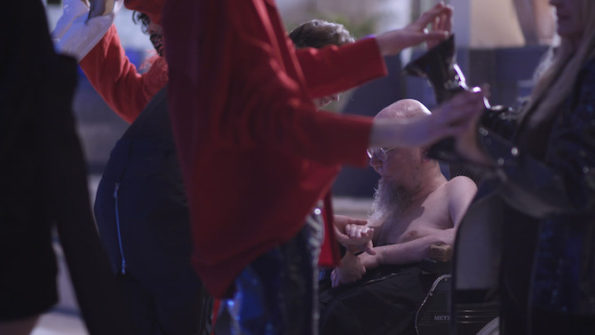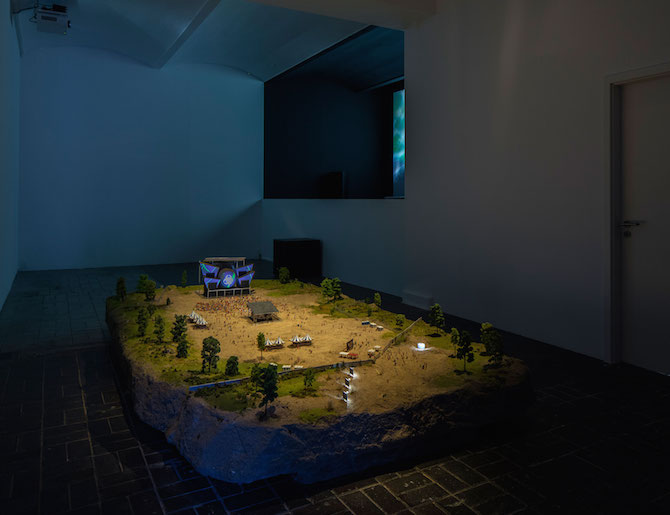Search
To search for an exact match, type the word or phrase you want in quotation marks.
A*DESK has been offering since 2002 contents about criticism and contemporary art. A*DESK has become consolidated thanks to all those who have believed in the project, all those who have followed us, debating, participating and collaborating. Many people have collaborated with A*DESK, and continue to do so. Their efforts, knowledge and belief in the project are what make it grow internationally. At A*DESK we have also generated work for over one hundred professionals in culture, from small collaborations with reviews and classes, to more prolonged and intense collaborations.
At A*DESK we believe in the need for free and universal access to culture and knowledge. We want to carry on being independent, remaining open to more ideas and opinions. If you believe in A*DESK, we need your backing to be able to continue. You can now participate in the project by supporting it. You can choose how much you want to contribute to the project.
You can decide how much you want to bring to the project.

To work to dismantle in the very context that is supposed to be for production. The edition of the Berlin Biennale curated by DIS is something like a series of conceptual twists with a political charge. And it’s another politics, a politics that is not read at such; one far removed from the political system, one that supposes a revolution. Evidently not everyone can see it and some–what is more- are not going to want to see the possibilities, given that it is then when positions of contextual power can reveal themselves as conservative from one day to the next.
Let’s begin again. DIS proposes a Biennale that sends out a quantity of important questions in terms of identity, geopolitics, mainstream, financial aesthetics and display. The Biennale questions substance and form through practice itself, from the present and from a field of reference distinct from that otherwise assumed. Let’s see, that they incorporate Rihanna within a contextual framework and don’t cite Walter Benjamin or the other “usual suspects” from the mechanical texts of art, does not mean that a discursive basis doesn’t exist. What occurs is that another grammar also appears, another type of distance. And this is disarming, disturbing, it obliges one to reconsider everything and resituate one’s position. Then comes the fear and discomfort, then the endeavour to eliminate the possibility of other modes of acting, being, or feeling. The title is The Present in Drag. And yes, there’s a twist, there’s change, there’s complexity and there’s the possibility for all of it.
The selection of spaces is by no means casual, neither is the type of emotional proposal in each one of them. A business school and a tourist boat: the new “urban” structure, the gaze and imposition of tourists, the future of cities through an economic definition. A world of finance and tourism, the layers of a dominant reality. A bunker and the two key places within the city’s art scene as are KW and the Akademie der Künste. It’s in KW and the Akademie where we find two methodologies for discourse that, seem, in principle, somewhat contradictory. The discourses do not necessarily have to be closed and here lies their complexity
In KW the exhibition is a linear pathway with an emotional charge, almost a rollercoaster that dismantles identity and relations, while also dismantling the exhibition and language of exhibitions. To begin, darkness: a series of video pieces, as well as the performance piece by Alexandra Pirici, in which a series of narratives are broken down in time and pixels question the new limits. With her installation, Cécile B. Evans manages to generate a dynamic in which the object-based and the digital have a shared and harmonious logic through the construction of the individual through doubts. And the construction is as much physical as the manner itself, as well as on a linguistic level. One of those key moments comes with the video of Alexa Karolinski & Ingo Niermann: Army of love presents another possibility for love, another type of contact. It’s skin, it’s impossibility, a crossing of gazes without the need for words. There are caresses, there is fragility and pain but there is also power and strong positions. In fact, Army of love could function almost as a statement for the whole biennale: it focuses on that place that is unrecognisable, offering another type of social possibility, another type of exchange beyond the dominant labour and generational structure. There is a way out and it is in the present, but it calls for a reassessing of much of the assumed. Above all, a foregoing of established codes to plunge into the emotional field with no holds barred. And here we are and thereupon the twists begin; in the moments of transit the exhibition exploits the aesthetics of finance through the voice of DIS itself. Corridors filled with the scintillating phrases, photographs and colours we share as the background of our ordinary lives. “Stop looking at me like I’m the future”. “I miss the conspiracy”. But exhibited, so that this aesthetic is called into question at the same time that the whole idea of the aesthetics of the exhibition must be reconsidered”. And it hurts, obviously. It’s a double twist, it’s thinking about whether it’s possible to be critical with the invisible, the invisible in the exhibition as much as the invisible of economic dominance. An effect similar to that of the video of Karolinski & Niermann: a friendly, frontal attack.

The exhibition in KW follows with leaps between the idea of display and the emotive construction through snippets, between darkness and natural light, in a continuous process of dismantling that accumulates layers that seem contradictory: the physical and the broken narrative of a thought in various temporal lines all at the same time. Anne de Vries and the idea of a community of individuals in a rave, the digital construction of beings that need to be surrounded to be alone, feeling the base beat enter into your body in an enormous techno session. And at the same time, the ritual via Wu Tsang in which history and tradition in martial arts pass as being a good base for dis-identity. Mass and subject, body and process. To return to the object through emotional impossibility in the face of all those emails from companies that we receive in our names, and Camille Henrot giving answers tailor made for such the intrusion-ism of our accounts but returns to the material, to the object, to odour. And it’s strange, as if there is something wrong, as if the medium is not the message and the present is already over.
If there is a linear pathway at KW, at the Akademie der Künste there is an explosion. The space in itself, with its transparent architecture and bank aesthetic, directly forces the question of what are we doing here. There is a tension between the pieces and the space, there is a constant displacement; there is impossibility and misalignment. Well, life. Well, history. Well, the future. Simon Fujiwara and his false museum revolving around economic happiness, usurping the aesthetics of the museum, bringing it close to that of a cheap department store. Lizzie Fitch and Ryan Trecartin with their out of control aesthetics, a post-television do it yourself. Centre for Style mixing clothing, vitrines, leftovers and bits of trash, with which the trained gaze suffers and the categories tumble. Without forgetting that Hito Steyerl is in the basement. In the basement. Above in the light, the sound escapes and Halil Altindere torments us with a video, in which rap and an aesthetic somewhere between art, independent video-clip, and fashion advertising, serves to talk about frontiers and people, about migration and struggles. The video hounds many of the works in the exhibition, occupying their physical space through sound. There is malaise, and it’s good that there is. In the academy the levels are maladjusted and history is constructed without following the customary structures: the material is in the present and there is no categorisation. As if it was a story recounted through a logical correlation between queer theory and the reformulation of the object, between optimism and failure, in an assumption that the present doesn’t wait, and that hence, the past is in doubt. There is play; there is violence, with changes of rhythm and tone. There are items without a plot, there is discursive capacity without discourse; there are material and moments bordering on the ridiculous, something that is incredibly brave in a world where security is the hard currency.
The present in drag requires work. It’s a Biennale that ultimately, responds to what an event of this type has to be: a situation that forces us to reconsider where we are going, that obliges an inexact position and makes possible a framework for action beyond the present moment. It’s not about being quickly resumed in “it’s about this” it’s not about a headline before passing on to the next one. It’s happening and happening very quickly, but wait, watch, feel, and afterwards begin to work at dismantling everything, there is a lot to be done.

Director of Index Foundation, Stockholm, exhibition curator and art critic. Yes, after Judith Butler it is possible to be several things at once. He thinks that questions are important and that, sometimes, to ask means to point out.
"A desk is a dangerous place from which to watch the world" (John Le Carré)